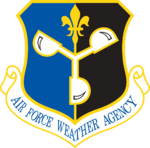| 54th Weather Reconnaissance Squadron | |
|---|---|
 Emblem of the 54th Weather Reconnaissance Squadron | |
| Active | 1944-1987 |
| Country | United States |
| Branch | United States Air Force |
| Type | Weather Reconnaissance |

Squadron emblem
The 54th Weather Reconnaissance Squadron is an inactive United States Air Force unit. Its last assignment was to the 41st Rescue and Weather Reconnaissance Wing, stationed at Andersen Air Force Base, Guam. It was inactivated on 30 September 1987.
History[]
Established in mid-1944 in England as a weather reconnaissance squadron; it was assigned to the Eighth Air Force. The squadron's primary mission was acquiring accurate weather information over enemy-occupied Continental Europe, including Nazi Germany for mission planning of heavy bombardment missions to identified enemy industrial, transportation and military targets. It flew a wide variety of medium bombers and fighter aircraft, all at high speed and unarmed over enemy-held territory on a daily basis. These missions were highly hazardous and usually flown without any escort. The squadron continued operations until the German capitulation in May 1945, when it returned to the United States.
Redeployed to North Field, Guam and issued very long range B-29 Superfortress bombers, it was fitted-out with weather reconnaissance equipment in September 1945. The unit flew weather reconnaissance missions for the Far East Air Forces during the early postwar years, inactivating in October 1947.
It was reactivated in 1951 at North Field (later Anderson AFB), Guam. The squadron resumed its weather reconnaissance mission with WB-29s; upgrading to WB-50D Superfortresses in 1955. It often flew hazardous reconnaissance missions into tropical storms and typhoons to obtain accurate meteorological information. It was inactivated in 1960 due to budget reductions. The squadron was reactivated in 1960 with a mixture of WB-50s, WB-47s and C-130s and resumed its typhoon hunting mission. The squadron was the last operator of the WB-50D Superfortress, retiring the last aircraft in 1965, when it operated C-130s. Perhaps its best accomplishment was during the Vietnam War when Operation Popeye (Project Popeye/Motorpool/Intermediary-Compatriot) was a US military cloud seeding operation (running from March 20, 1967 until July 5, 1972) to extend the monsoon season over Laos, specifically areas of the Ho Chi Minh Trail. The operation seeded clouds with silver iodide, resulting in the targeted areas seeing an extension of the monsoon period an average of 30 to 45 days. As the continuous rainfall slowed down the truck traffic, it was considered relatively successful. The 54th Weather Reconnaissance Squadron carried out the operation to "make mud, not war." It was inactivated in 1987.
Lineage[]
- Constituted as the654th Bombardment Squadron (Heavy, Reconnaissance, Special) on 17 Jul 1944
- Activated on 9 Aug 1944
- Redesignated the 54th Reconnaissance Squadron (Long Range, Weather) on 4 Sep 1945
- Redesignated the 54th Reconnaissance Squadron (Very Long Range, Weather) on 27 Nov 1945
- Inactivated on 15 Oct 1947
- Redesignated the 54th Strategic Reconnaissance Squadron (Medium, Weather) on 22 Jan 1951
- Activated on 21 Feb 1951
- Redesignated the 54th Weather Reconnaissance Squadron on 15 Feb 1954
- Discontinued on 18 Mar 1960
- Activated on 8 Feb 1962
- Organized 18 Apr 1962
- Inactivated on 30 Sep 1987
Assignments[]
- 25th Bombardment Group (Reconnaissance), 9 Aug 1944
- Third Air Force, 8 Sep 1945
- 311th Reconnaissance Wing, 27 Nov 1945
- Attached to the Twentieth Air Force, 8 Dec 1945-28 Feb 1946
- Air Weather Service, 13 Mar 1946
- 43d Weather Wing, 1 Aug-15 Oct 1947
- 2143d Air Weather Wing, 21 Feb 1951
- 1st Weather Wing, 8 Feb 1954
- Department of the Air Force, 18 Mar 1960
- Military Air Transport Service, 8 Feb 1962
- 9th Weather Reconnaissance Group, 18 Apr 1962
- 9th Weather Reconnaissance Wing, 1 Jul 1965
- 41st Rescue and Weather Reconnaissance Wing, 1 Sep 1975-30 Sep 1987
Stations[]
- RAF Watton (AAF-376), England, 9 Aug 1944
- Drew Field, Florida, Aug 1945
- North Field, Guam, 27 Nov 1945-Mar 1946
- Buckley Field, Colorado, Mar 1946-2 Jun 1946
- Langley Field, Virginia, 2 Jun 1946-Jul 1946
- Morrison Field, Florida, Jul 1946-30 Jun 1947
- McClellan Field, California, 1 Jul 1947
- Fairfield-Suisun Army Air Base, California, 31 Jul 1947
- North Army Air Base, Guam, 2 Aug 1947-15 Oct 1947
- Andersen AFB, Guam, 21 Feb 1951-18 Mar 1960; 8 Feb 1962-30 Sep 1987
Aircraft[]
- B-25 Mitchell, 1944
- de Havilland Mosquito XVI, 1944-1945
- B-26 Marauder, 1944-1945
- P-38 Lightning, 1944-1945
- B-29/WB29 Stratofortress, 1946-1947; 1951-1956
- C-47 Skytrain, 1946-1947
- C-54 Skymaster, 1951-1960
- YC-97 Stratofreighter, 1952-1953
- TB-50/WB-50 Superfortress, 1955; 1955-1960
- WB-50 Superfortress, WB-47 Stratojet, and C-130 Hercules, 1962-1965
- WC-130 Hercules, 1965-1987
References[]
This article incorporates public domain material from the Air Force Historical Research Agency website http://www.afhra.af.mil/.
| |||||||||||||||||||||||||||||||||
The original article can be found at 54th Weather Reconnaissance Squadron and the edit history here.
